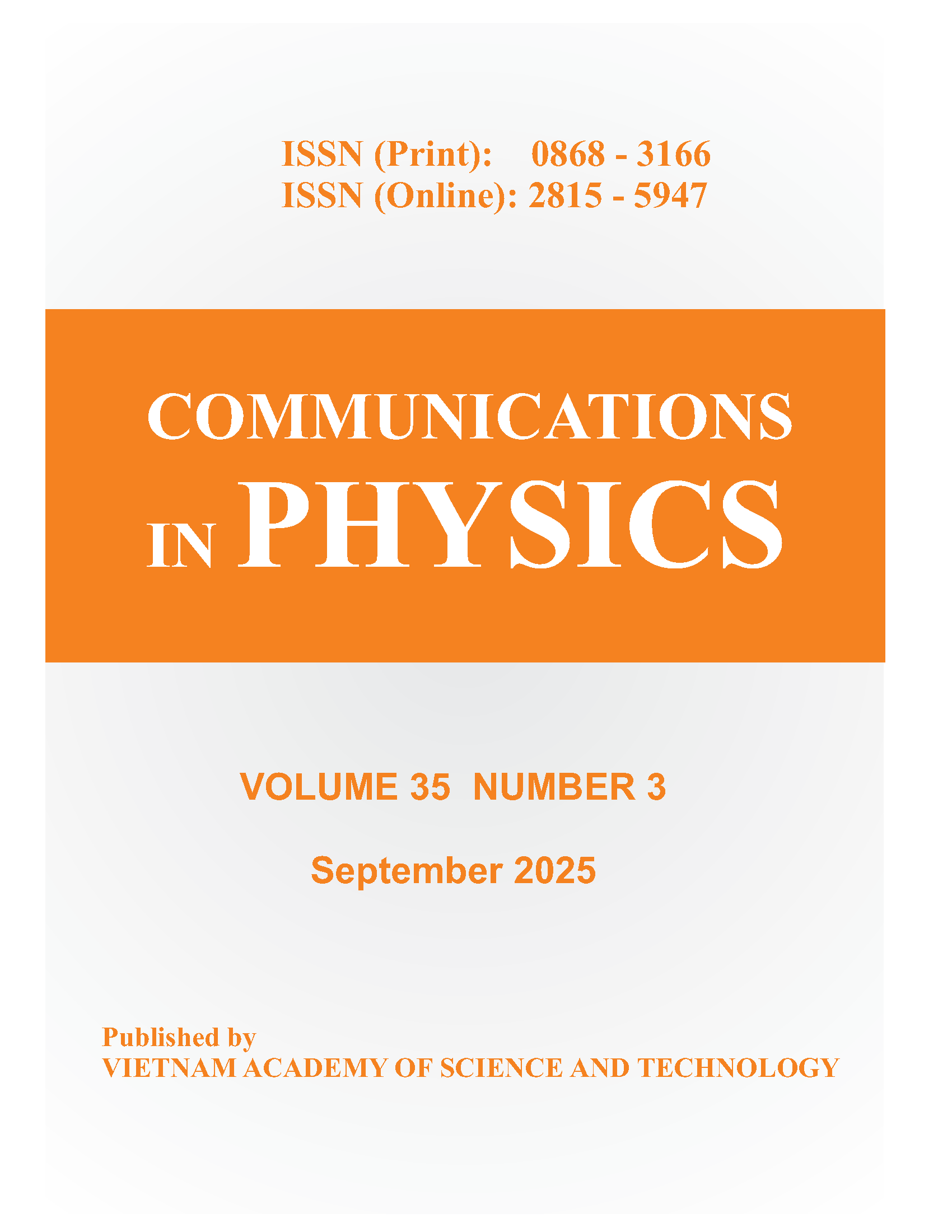Adsorption capacity of a hydrogen atom on the 2D silicon carbide surface
Author affiliations
DOI:
https://doi.org/10.15625/0868-3166/18091Keywords:
Density functional theory calculation, two-dimensional, silicon carbide, hydrogen adsorptionAbstract
Hydrogen adsorption on two-dimensional (2D) silicon carbide (SiC) was studied using molecular dynamics and ab initio calculations. By investigating a converged density functional theory (DFT) calculation, the stable adsorption sites of a hydrogen atom on the 2D SiC were found at the top sites (TSi and TC, of which the most stable adsorption site is TSi). The adsorption of a hydrogen atom on 2D silicon carbide led to local structural changes in silicon carbide.
Downloads
References
K. S. Novoselov, A. K. Geim, S. V. Morozov, D. Jiang, Y. Zhang, S. V. Dubonos et al., Electric field effect in atomically thin carbon films, Science 306 (2004) 666.
A. K. Geim and K. S. Novoselov, The rise of graphene, Nat. Mater. 6 (2007) 183.
L. Sun, Y. Li, Z. Li, Q. Li, Z. Zhou, Z. Chen et al., Electronic structures of SiC nanoribbons, 129 (2008) 174114.
T. Susi, V. Skákalová, A. Mittelberger, P. Kotrusz, M. Hulman, T. J. Pennycook et al., Computational insights and the observation of sic nanograin assembly: towards 2D silicon carbide, Sci. Rep. 7 (2017) 4399.
T. T. T. Hanh, N. M. Phi and N. Van Hoa, Hydrogen adsorption on two-dimensional germanene and its structural defects: an ab initio investigation, Phys. Chem. Chem. Phys. 22 (2020) 7210.
B. Aufray, A. Kara, S. Vizzini, H. Oughaddou, C. Léandri, B. Ealet et al., Graphene-like silicon nanoribbons on Ag (110): A possible formation of silicene, Appl. Phys. Lett. 96 (2010) 183103.
P. Vogt, P. De Padova, C. Quaresima, J. Avila, E. Frantzeskakis, M. C. Asensio et al., Silicene: Compelling experimental evidence for graphenelike two-dimensional silicon, Phys. Rev. Lett. 108 (2012) 155501.
S. Lin, S. Zhang, X. Li, W. Xu, X. Pi, X. Liu et al., Quasi-two-dimensional SiC and SiC2: interaction of silicon and carbon at atomic thin lattice plane, J. Phys. Chem. C 119 (2015) 19772.
H. C. Hsueh, G. Y. Guo and S. G. Louie, Excitonic effects in the optical properties of a sic sheet and nanotubes, Phys. Rev. B 84 (2011) 085404.
X. Lin, S. Lin, Y. Xu, A. A. Hakro, T. Hasan, B. Zhang et al., Ab initio study of electronic and optical behavior of two-dimensional silicon carbide, J. Mater. Chem. C 1 (2013) 2131.
A. Gali, Ab initio study of nitrogen and boron substitutional impurities in single-wall sic nanotubes, Phys. Rev. B 73 (2006) 245415.
B. Baumeier, P. Krüger and J. Pollmann, Structural, elastic, and electronic properties of SiC, BN, and BeO nanotubes, Phys. Rev. B 76 (2007) 085407.
M. Zhao, Y. Xia, F. Li, R. Q. Zhang and S.-T. Lee, Strain energy and electronic structures of silicon carbide nanotubes: Density functional calculations, Phys. Rev. B 71 (2005) 085312.
S. Plimpton, Fast parallel algorithms for short-range molecular dynamics, J. Comput. Phys. 117 (1995) 1.
P. Vashishta, R. K. Kalia, A. Nakano and J. P. Rino, Interaction potential for silicon carbide: A molecular dynamics study of elastic constants and vibrational density of states for crystalline and amorphous silicon carbide, Journal of Applied Physics 101 (2007) 103515.
C. L. Freeman, F. Claeyssens, N. L. Allan and J. H. Harding, Graphitic nanofilms as precursors to wurtzite films:
theory, Phys. Rev. Lett. 96 (2006) 066102.
S. Chabi, Z. Guler, A. J. Brearley, A. D. Benavidez and T. S. Luk, The creation of true two-dimensional silicon carbide, Nanomater. 11 (2021) 1799.
J. M. Soler, E. Artacho, J. D. Gale, A. García, J. Junquera, P. Ordejón et al., The SIESTA method for ab initio order-N materials simulation, J. Phys.: Condens. Matter 14 (2002) 2745.
T. T. T. Hanh and N. T. T. Hang, A DFT study of hydrogen electroadsorption on the missing row Pt ((1,1,0)-(1times 2)) surface, Comput. Mater. Sci. 138 (2017) 295.
T. T. T. Hanh and N. Van Hoa, Zero-point vibration of the adsorbed hydrogen on the Pt(110) surface., Adsorption 26 (2020) 453.
H.-D. Saßnick and C. Cocchi, Electronic structure of cesium-based photocathode materials from density functional theory: performance of PBE, SCAN, and HSE06 functionals, Electron. struct. 3 (2021) 027001.
V. Ivanovskaya, A. Zobelli, D. Teillet-Billy, N. Rougeau, V. Sidis and P. Briddon, Hydrogen adsorption on graphene: a first principles study, Eur. Phys. J. B 76 (2010) 481.
Downloads
Published
How to Cite
Issue
Section
License
Communications in Physics is licensed under a Creative Commons Attribution-ShareAlike 4.0 International License.
Copyright on any research article published in Communications in Physics is retained by the respective author(s), without restrictions. Authors grant VAST Journals System (VJS) a license to publish the article and identify itself as the original publisher. Upon author(s) by giving permission to Communications in Physics either via Communications in Physics portal or other channel to publish their research work in Communications in Physics agrees to all the terms and conditions of https://creativecommons.org/licenses/by-sa/4.0/ License and terms & condition set by VJS.
Funding data
-
Viet Nam National University Ho Chi Minh City
Grant numbers VL2022-20-02











